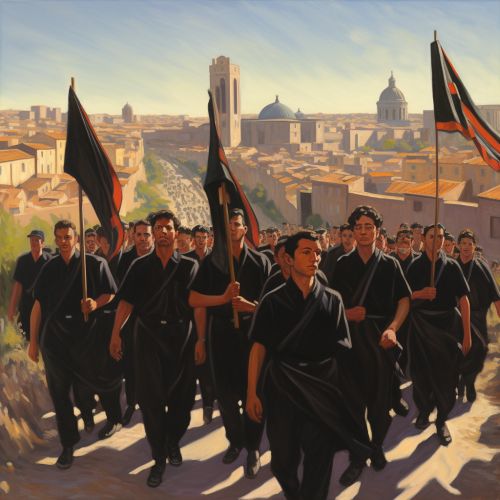March on Rome
Background
The March on Rome was a significant event in the history of Italy, marking the rapid and bloodless transition in 1922 from a democratic parliamentary system to a Fascist dictatorship under the leadership of Benito Mussolini. This event is often seen as the beginning of the totalitarian Fascist regime in Italy, which lasted until 1943.
Prelude to the March
In the early 20th century, Italy was experiencing a period of social unrest and political instability. The country had been embroiled in World War I, which had left it economically weakened and socially divided. The government was unstable, with frequent changes in leadership and a lack of clear direction. This created a fertile ground for the rise of radical political movements, including the National Fascist Party led by Benito Mussolini.
Mussolini, a former socialist and journalist, had formed the National Fascist Party in 1919. The party's ideology, known as Fascism, combined elements of nationalism, militarism, and corporatism. It promised to restore Italy's national pride and economic stability, and to suppress the socialist and communist movements that were gaining strength in the country.
In the early 1920s, the Fascist Party began to gain popularity, particularly among the middle classes, who were disillusioned with the existing political system and feared the rise of socialism. The Fascists also formed paramilitary squads known as Blackshirts, who used violence and intimidation against their political opponents.
The March
In October 1922, Mussolini decided to take advantage of the political instability and the growing strength of his party to seize power. He planned a mass demonstration in Rome, known as the March on Rome, to show the strength of the Fascist movement and to demand the resignation of the government.
On October 28, thousands of Blackshirts began to converge on Rome from different parts of the country. The government, led by Prime Minister Luigi Facta, was taken by surprise and was unsure how to respond. Facta initially proposed declaring a state of siege and using the army to suppress the Fascists, but King Victor Emmanuel III refused to sign the decree, fearing that it would lead to civil war.
As the Fascists continued their march towards Rome, the King decided to avoid bloodshed by offering Mussolini the position of Prime Minister. Mussolini, who was still in Milan, accepted the offer and took a train to Rome, where he arrived on October 30. He was sworn in as Prime Minister the same day, marking the beginning of the Fascist regime in Italy.
Aftermath
The March on Rome marked a turning point in Italian history. It signaled the end of the liberal parliamentary system and the beginning of the Fascist dictatorship. Mussolini consolidated his power over the next few years, suppressing political opposition, controlling the media, and creating a personality cult around himself.
The Fascist regime pursued aggressive foreign policies, leading to the invasion of Ethiopia in 1935 and the alliance with Nazi Germany in the late 1930s. The regime also implemented a series of social and economic policies aimed at modernizing the country and promoting national unity.
The Fascist regime lasted until 1943, when Mussolini was deposed and arrested following the Allied invasion of Sicily. However, the legacy of the March on Rome and the Fascist period continues to influence Italian politics and society to this day.
See Also
Fascist Italy (1922–1943) Benito Mussolini Victor Emmanuel III of Italy Blackshirts


